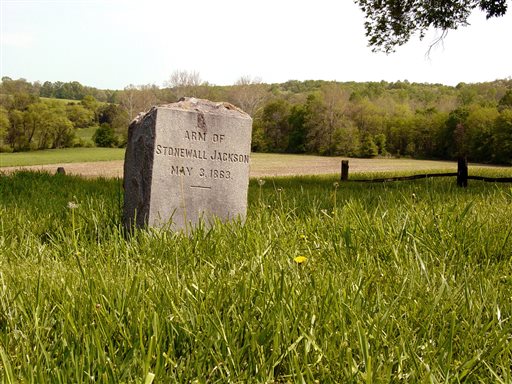 This photo provided by National Park Service shows a tombstone for a the amputated arm of Confederate Gen. Thomas J. "Stonewall" Jackson near Orange County, Va. An astronomer on the 150th anniversary of Jackson's death has reported in the May issue of "Sky & Telescope" magazine that some North Carolina soldiers were peering directly toward a rising full moon the fateful night they accidentally shot their beloved lieutenant general - and because of the low-hanging moon it would have been hard to tell friend from foe.
This photo provided by National Park Service shows a tombstone for a the amputated arm of Confederate Gen. Thomas J. "Stonewall" Jackson near Orange County, Va. An astronomer on the 150th anniversary of Jackson's death has reported in the May issue of "Sky & Telescope" magazine that some North Carolina soldiers were peering directly toward a rising full moon the fateful night they accidentally shot their beloved lieutenant general - and because of the low-hanging moon it would have been hard to tell friend from foe.RALEIGH, N.C. - Friendly fire felled Thomas J. "Stonewall" Jackson under a full moon in the thick of the northern Virginia wilderness during the Civil War. Ever since, debate has waxed and waned much like the moon over whether his fighters carelessly shot the legendary Confederate under a bright night sky - or mistook him for an approaching enemy.
Now an astronomer on the 150th anniversary of Jackson's death has reported in the May issue of "Sky & Telescope" magazine that some North Carolina soldiers were peering directly toward a rising full moon the fateful night they accidentally shot their beloved lieutenant general - and because of the low-hanging moon it would have been hard to tell friend from foe.
Donald Olson, who teaches astronomy and physics at Texas State University, concluded with colleague Laurie Jasinski that while others concentrate on the full moon and the unusual night fighting in Virginia when Jackson was shot, the relevant issue for him was the moon's position the night of May 2, 1863.
Jackson had made the unusual decision that night to keep fighting at the Battle of Chancellorsville. It was about 9 p.m. when he rode up with a group to scout out Union lines. Upon returning, the North Carolina soldiers mistook the group for the enemy and shot Jackson, hitting him three times.
Hours afterward, doctors at a field hospital amputated Jackson's left arm. And the next day, the Confederates drove away the Union forces, protecting the Confederate capital of Richmond. But a deteriorating Jackson died on May 10, 1863. He was 39.
According to Olson's calculations, the moon had reached an altitude of 25 degrees above the horizon when Jackson was shot. He and Jasinski concluded soldiers of the 18th North Carolina Infantry Regiment who shot Jackson were looking to the southeast, directly toward the rising moon.
The moon's angle would have placed Jackson and his entourage in silhouette, they concluded in their article, "Stonewall Jackson in the Moonlight."
"The riders would have appeared as dark figures, not recognizable, so our astronomical analysis partially absolves the 18th North Carolina from blame for the wounding of Jackson," they wrote, adding they consulted Confederate almanacs from 1863 and checked the moon's position using planetarium computer programs.
Olson, who teaches a class titled "Astronomy in Art, History and Literature," has investigated the influence of the moon and tides on other historical events, including how an unusual lunar configuration in early 1912 may have played a role in sending icebergs into shipping lanes, contributing to the sinking of the Titanic.
Jackson biographer James I. Robertson Jr. doesn't accept Olson's theory about the moonlight. He said Jackson was shot in a dark, wooded area, where the brightness of the moon wouldn't have mattered.
"Quite frankly, I'm not sure they would have seen the moon, given the wilderness, gun smoke and darkness and killing," he said. "And you don't look up at the sky unless you're dying."
He does agree, however, that the 18th North Carolina isn't responsible. He places that blame squarely on Jackson. As a lieutenant general, Jackson shouldn't have been checking on enemy lines himself. And when he turned around, he didn't retrace his exact steps, having traveled too far north when he set out.
"That was his fatal mistake," Robertson said. "He came in at another point of his line. And you can make a case that Jackson had no business doing his own reconnoitering."
That was unusual since Jackson's feats of military prowess had made him a hero throughout the South and a villain to the North.
Gen. Robert E. Lee famously remarked after the shooting: "He has lost his left arm, but I have lost my right arm." Some contend the top Confederate general never fully recovered from the death of "Stonewall," whose famous moniker was bestowed on him at the first Battle of Manassas.
When Jackson's body lay in state in Richmond, 25,000 people filed by the casket to say farewell, a number still unmatched in the history of the former Confederate capital, Robertson said.
And the men of the 18th North Carolina took their mistake hard. John Barry, the Confederate who gave the order to fire on Jackson's party, was 27 when he died less than two years after the Civil War ended. His family said the cause was a broken heart owing to his ill-fated order, said Robertson. Two veterans who concluded they had killed Jackson committed suicide, he noted.
"You might imagine what it was like, leading to the death of one of their beloved generals," Jasinski said. "There was a lot of criticism leveled at the 18th North Carolina. Our research partially absolves the 18th North Carolina of some of the blame since they couldn't easily recognize him."
